Wondering, how much food you should feed your guppies?
You’re in the right place! I’m going to answer the same question in this article.
You should feed once or twice a day to your guppies. If you want to feed two times every day then keep a gap of at least 10-12 hours between the meals. Each time you should feed the amount of food your guppies can consume within one minute. Feed a varied diet for the healthy growth of your guppies.
Now you have the short answer to the question. But there is a bit more you should know on this topic before you start feeding your guppies.
I’ve covered everything else you should know on this topic below.
Keep reading…
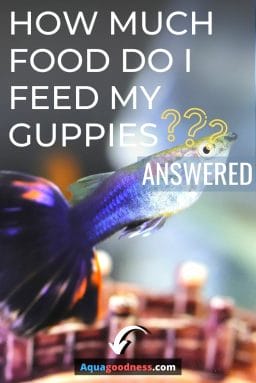
Table of Contents
How much each type of fish food should I feed my guppies?
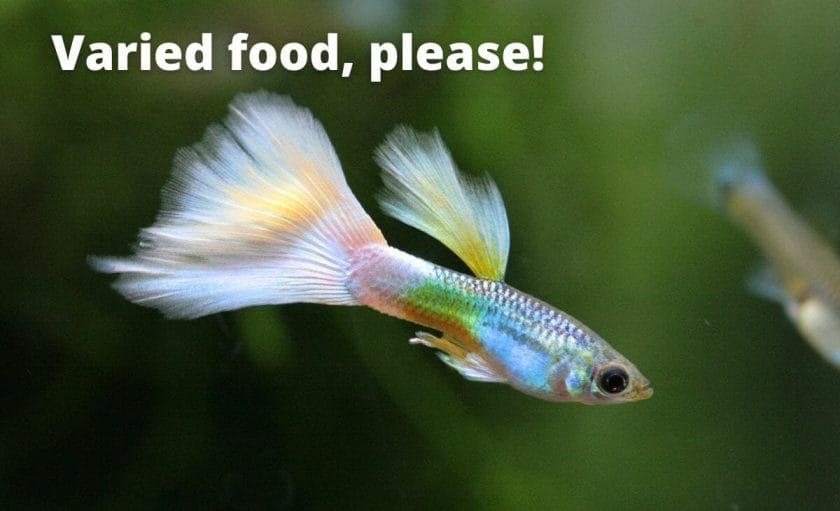
Guppies are omnivorous so you will need to feed them a varied diet for their proper growth and development.
Ideally, you should feed them prepared food such as flakes and pellets as well as frozen and dried live food such as daphnia and brine shrimp.
Now I am going to tell you how much and how to feed each type of food to your guppies.
How much flake food should I feed my guppies?
Flakes food is one of the oldest and common fish food in the aquarium hobby.
Tropical flake food generally contains all the nutrients that guppies require for their proper growth and development.
To feed flake food to your guppies- take a small pinch of flake food, crush it, and then put it in your aquarium.
You should feed the amount of flake food that your guppies can consume within 1 minute.
Exactly how much flake food you should feed your guppies depends on the number of fish you have in your fish tank.
For example, if you have a lot of fish in your fish tank then probably you will need to add two to three small pinches of flake food to feed them all.
On the other hand, if you don’t have a lot of fish in your tank, say you have only 5 guppies in your fish tank then feeding one or two small pinches of flake food will be sufficient.
Friendly Reminder- Just remember you should feed the amount of flake food your guppies can consume within 1 minute.
Basically, after adding a small pinch of flake food in your fish tank, if your guppies consumed it within 30 seconds then you will need to add another small pinch of flake food into the tank.
After feeding your guppies a few times you’ll get an idea about exactly how much flake food your guppies need!
How to choose the best flake foods for your guppies?
There are a lot of flake foods available for guppies.
While choosing the flake food for your guppies make sure that it contains some meaty ingredients like salmon and shrimp etc and not just filler ingredients like wheat.
Note- Remember any flake food will contain some filler ingredients to bind everything together. Again, while choosing the flake food for your guppies just make sure that the flake food contains some meaty ingredients and not just filler ingredients
Best flake food for guppies
Here are some of my recommended flake food for your guppies.
| Flake food | Features | Check price at Amazon |
| New Life Spectrum Optimum Flakes | – Includes both meaty and plant-based ingredients – Enhances guppy fish color – Improves immune system | Click here |
| Aquacarium Tropical Flakes | – Includes both meaty and plant-based ingredients – All natural – Does not cloud the water | Click here |
| Tetra Tropical Color Flakes | – Very popular – Includes both meaty and plant-based ingredients – Enhances guppy fish color – Does not cloud the water | Click here |
Flake food generally floats on the surface of the water of your aquarium so the leftover flake food is very easy to remove after feeding your guppies.
Why removing the leftover feed fish food is important I am going to talk about it later in detail below
This might also interest you- How Can I Enhance My Guppy Color? (11 Easy Tips)
How much pellets should I feed my guppies and how to feed them?
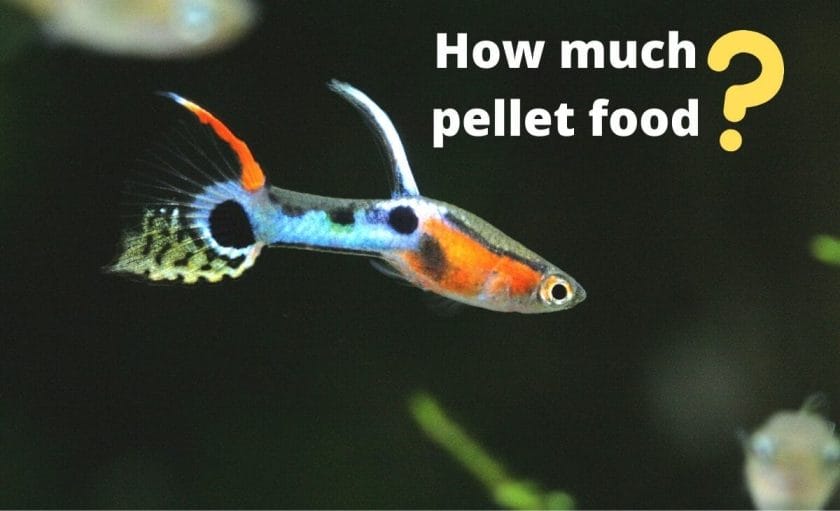
Pellets are denser and so more nutritious than flake foods.
There are sinking pellets as well as floating pellets available in the market.
You should feed the amount of pellets that you are guppies can consume within one minute.
You should add a small pinch of pellets to your guppy fish tank. If your guppies consumed all the pellets within a minute then you can add another small pinch of pellets.
How to choose the best pellets for your guppies?
While choosing pellets for your guppies make sure that the pellets contain at least a couple of meaty ingredients such as skrill or squid or any other meaty ingredient.
These meaty ingredients contain a lot of protein so they are very good for the growth and development of your guppies.
Best pellets for guppies
Here are some of my recommended pellet food for your guppies
| Pellet foods | Key features | Check price at Amazon |
| New Life Spectrum Float Surface Feeder | – Includes both meaty and plant-based ingredients – All-natural ingredients – Enhances guppy fish color – Semi-floating | Click here |
| Hikari Micro Pellets | – Includes both meaty and plant-based ingredients – Semi-floating – Does not cloud the water | Click here |
You may be interested in- Are Guppies Easy to Take Care of? (Guppy Care Guide Included)
How much frozen food should I feed my guppies and how to feed it
Frozen foods are generally the most nutritious foods you can feel your guppies.
You can feed frozen foods like brine shrimp and daphnia to your guppies.
Exactly how you should feed these frozen foods depends on the brand you choose because the packaging of the products varies.
For example, feeding baby brine shrimp is very easy.
Here is a video that shows you exactly how to feed it.
You can check its reviews and latest price at Amazon here.
You can also feed daphnia to your guppies.
You should feed the amount of daphnia your guppies can consume within 1 minute
Start with a small amount of daphnia and add more if your guppies consumed it within a minute.
How much vegetables should I feed my guppies and how to feed them?
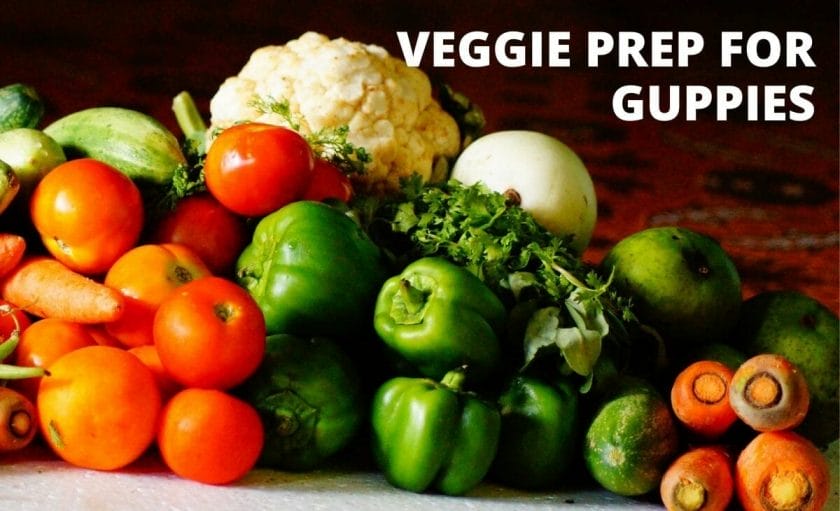
You heard it right! You can actually feed vegetables to your guppies!
Guppies are omnivorous so along with meaty foods they will also need some plant-based foods for their proper growth and development.
And there are a variety of vegetables you can feed your guppies.
You can feed the following vegetables to your guppies
- Spinach leaves
- Cauliflower
- Zucchini/Courgette
- Kale
- Lettuce (You can find both Iceberg lettuce and Romaine lettuce)
- Mustard greens
- Broccoli
- Potato (You can feed both sweet and regular potatoes)
- Carrot
- Bell peppers
- Green beans
- Peas
- Pumpkin
- Cabbage
- Corn (Is it a vegetable or fruit? Anyways, your guppies can eat it!)
Here again, a good rule of thumb to follow when it comes to the amount of vegetables you should feed to your guppies is – feed the amount of vegetable that your guppies can consume within 1 minute.
Before feeding the vegetables to your guppies you will need to prepare them.
Don’t worry, the preparation process is very simple and quick!
Exactly how you should prepare the vegetables depends on the vegetable you are going to feed your guppies.
Actually, I have written a detailed article covering the methods that you will need to use to prepare each type of vegetable. You can read the article here.
Besides vegetables, you can also feed veggie fish foods to your guppies. The veggie fish foods contain only plant-based ingredients.
Here are some of my recommended veggie fish food for your guppies
| Veggie fish food | Features | Check price at Amazon |
| Aquacarium Veggie Flakes | – Flake food – All natural ingredients – Does not cloud the water | Click here |
| New Life Spectrum AlgaeMax | – Sinking wafer – Made from algae | Click here |
How much food should I feed my guppies? (weekly plan)
Guppies are omnivorous so they need both plant-based foods and meaty foods in their diet for their proper growth and development.
So throughout the week, ideally, you should feed them different varieties of food such as flake food, and pellets, and frozen foods.
Feeding two times every day
To keep things simple, if you are going to feed your guppies 2 times a day (one time in the morning and one time at night) then you should feed prepared foods such as flakes or pellets in the morning. And you should feed frozen foods like daphnia and brine shrimp at night.
Feeding only one time every day
If you are going to feed your guppies only one time every day then you should feed the prepared foods like flakes and pellets and frozen food like daphnia and brine shrimp consecutively throughout the week.
For example, on Monday you should feed prepared food like flake food and on Tuesday you should feed frozen live food like brine shrimp and then on Wednesday you should again feed prepared food and so on…
If you feed your guppies is this way then your guppies will get all the nutrients that they need for their proper growth and development.
Thought this might help- 11 Easy Ways to Keep Your Guppies Happy and Healthy
Always make sure to remove the uneaten food from your fish tank!
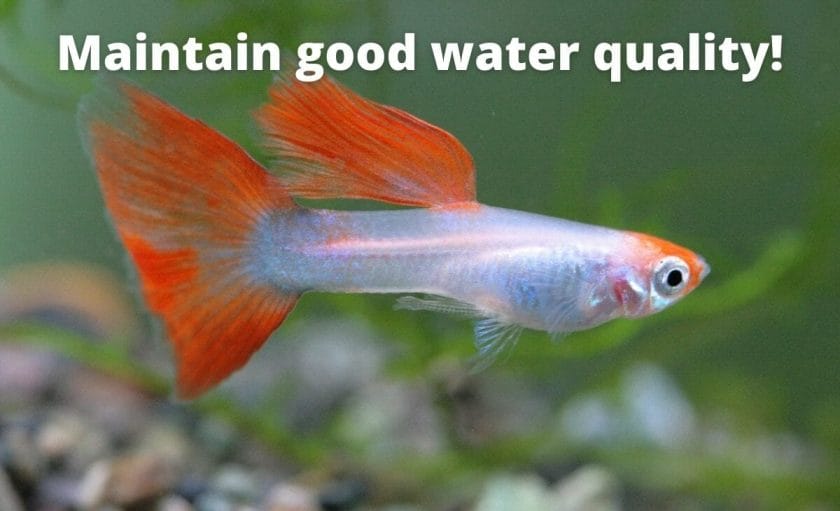
After feeding your guppies, after about one hour, you should remove any uneaten food from your fish tank.
It is very important to remove the uneaten food because, if you don’t, then the food will break down in your fish tank and it will produce ammonia in your fish tank.
Even a slight level of ammonia can be deadly for your guppies!
That’s why you should always remove the uneaten food after feeding your guppies.
How to remove the uneaten food from your fish tank?
To remove the floating uneaten food from your fish tank like flake food you can use a fishnet (link to Amazon)
To remove the sinking fish food like pellets from the bottom of your fish tank you can use a siphon (link to Amazon)
Conclusion
Overall, you should feed once or twice a day to your guppies.
If you want to feed twice a day then just make sure to keep a gap of at least 10 to 12 hours between feeding times.
Exactly how much food you should feed to your guppies each time depends on the number of fish you have in your fish tank.
A good rule of thumb to follow is to feed the amount of food your guppies can consume within 1 minute.
Besides, the details I have given about how much to feed each type of food and how to feed it will hopefully clear your other doubts.
I hope you found this article helpful.
If you do, please share it.
Happy fishkeeping!